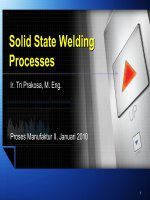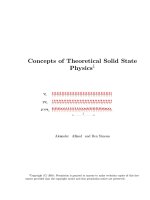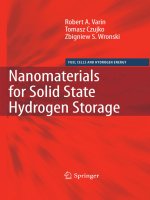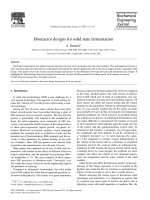Solid state chemistry
Bạn đang xem bản rút gọn của tài liệu. Xem và tải ngay bản đầy đủ của tài liệu tại đây (13.03 MB, 483 trang )
A N I NTR O D U CTI O N
www.pdfgrip.com
A N I NTR O D U CTI O N
www.pdfgrip.com
www.pdfgrip.com
A N I NTR O D U CTI O N
Boca Raton London New York
CRC Press is an imprint of the
Taylor & Francis Group, an informa business
www.pdfgrip.com
CRC Press
Taylor & Francis Group
6000 Broken Sound Parkway NW, Suite 300
Boca Raton, FL 33487-2742
© 2012 by Taylor & Francis Group, LLC
CRC Press is an imprint of Taylor & Francis Group, an Informa business
No claim to original U.S. Government works
Version Date: 20120106
International Standard Book Number-13: 978-1-4398-4792-3 (eBook - PDF)
This book contains information obtained from authentic and highly regarded sources. Reasonable efforts
have been made to publish reliable data and information, but the author and publisher cannot assume
responsibility for the validity of all materials or the consequences of their use. The authors and publishers
have attempted to trace the copyright holders of all material reproduced in this publication and apologize to
copyright holders if permission to publish in this form has not been obtained. If any copyright material has
not been acknowledged please write and let us know so we may rectify in any future reprint.
Except as permitted under U.S. Copyright Law, no part of this book may be reprinted, reproduced, transmitted, or utilized in any form by any electronic, mechanical, or other means, now known or hereafter invented,
including photocopying, microfilming, and recording, or in any information storage or retrieval system,
without written permission from the publishers.
For permission to photocopy or use material electronically from this work, please access www.copyright.
com ( or contact the Copyright Clearance Center, Inc. (CCC), 222 Rosewood
Drive, Danvers, MA 01923, 978-750-8400. CCC is a not-for-profit organization that provides licenses and
registration for a variety of users. For organizations that have been granted a photocopy license by the CCC,
a separate system of payment has been arranged.
Trademark Notice: Product or corporate names may be trademarks or registered trademarks, and are used
only for identification and explanation without intent to infringe.
Visit the Taylor & Francis Web site at
and the CRC Press Web site at
www.pdfgrip.com
Dedicated to our children
Sam and Laura,
and
Graham and Rosemary
www.pdfgrip.com
www.pdfgrip.com
Contents
Preface to the Fourth Edition.................................................................................... xv
Preface to the Third Edition...................................................................................xvii
Preface to the Second Edition..................................................................................xix
Preface to the First Edition......................................................................................xxi
Authors.................................................................................................................. xxiii
List of Units, Prefixes, and Constants.....................................................................xxv
Chapter 1 An Introduction to Crystal Structures...................................................1
1.1
1.2
1.3
1.4
1.5
1.6
Introduction................................................................................ 1
Close Packing.............................................................................2
Body-Centred and Primitive Structures.....................................6
Symmetry................................................................................... 8
1.4.1 Symmetry Notation.......................................................9
1.4.2 Axes of Symmetry........................................................9
1.4.3 Planes of Symmetry.................................................... 10
1.4.4 Inversion...................................................................... 11
1.4.5 Inversion Axes and Improper Symmetry Axes
and the Identity Element............................................. 11
1.4.6 Operations................................................................... 13
1.4.7 Symmetry in Crystals.................................................. 13
Lattices and Unit Cells............................................................. 14
1.5.1 Lattices........................................................................ 14
1.5.2 One- and Two-Dimensional Unit Cells....................... 15
1.5.3 Translational Symmetry Elements.............................. 16
1.5.4 Three-Dimensional Lattices and Their Unit Cells...... 18
1.5.5 Miller Indices.............................................................. 23
1.5.6 Interplanar Spacings....................................................25
1.5.7 Packing Diagrams.......................................................25
Crystalline Solids..................................................................... 27
1.6.1 Ionic Solids with Formula MX...................................28
1.6.2 Solids with General Formula MX2............................. 33
1.6.3 Other Important Crystal Structures............................ 37
1.6.4 Ionic Radii...................................................................40
1.6.5 Extended Covalent Arrays.......................................... 47
1.6.6 Bonding in Crystals..................................................... 49
1.6.7 Atomic Radii............................................................... 51
1.6.8 Molecular Structures................................................... 51
1.6.9 Silicates....................................................................... 54
1.6.10 Quasicrystals............................................................... 57
vii
www.pdfgrip.com
viii
Contents
1.7
Lattice Energy.......................................................................... 59
1.7.1 Born–Haber Cycle....................................................... 59
1.7.2 Calculating Lattice Energies....................................... 61
1.7.3 Calculations Using Thermochemical Cycles
and Lattice Energies.................................................... 67
1.8 Conclusion................................................................................ 69
Questions............................................................................................. 70
Chapter 2 Physical Methods for Characterising Solids....................................... 75
2.1
2.2
Introduction.............................................................................. 75
X-Ray Diffraction..................................................................... 75
2.2.1 Generation of X-Rays.................................................. 75
2.2.2 Diffraction of X-Rays.................................................. 77
2.3 Powder Diffraction................................................................... 79
2.3.1 Powder Diffraction Patterns........................................ 79
2.3.2 Absences Due to Lattice Centring..............................80
2.3.3 Systematic Absences Due to Screw Axes
and Glide Planes..........................................................84
2.3.4 Uses of Powder X-Ray Diffraction.............................. 86
2.4 Single Crystal X-Ray Diffraction.............................................90
2.4.1 Importance of Intensities.............................................90
2.4.2 Solving Single Crystal Structures............................... 93
2.4.3 High-Energy X-Ray Diffraction.................................. 95
2.5 Neutron Diffraction..................................................................96
2.5.1 Uses of Neutron Diffraction...................................... 100
2.6 Electron Microscopy.............................................................. 101
2.6.1 Scanning Electron Microscopy................................. 102
2.6.2 Transmission Electron Microscopy........................... 104
2.6.3 Energy Dispersive X-Ray Analysis........................... 107
2.6.4 Scanning Transmission Electron Microscopy........... 108
2.6.5 Electron Energy Loss Spectroscopy......................... 108
2.6.6 superSTEM............................................................... 111
2.7 Scanning Probe Microscopy.................................................. 111
2.7.1 Scanning Tunnelling Microscopy............................. 112
2.8 Atomic Force Microscopy...................................................... 114
2.9 X-Ray Absorption Spectroscopy............................................ 116
2.9.1 Extended X-Ray Absorption Fine Structure............. 116
2.9.2 X-Ray Absorption Near-Edge Structure and
Near-Edge X-Ray Absorption Fine Structure........... 122
2.10 Solid-State Nuclear Magnetic Resonance Spectroscopy.......... 124
2.11 Thermal Analysis................................................................... 128
2.11.1 Differential Thermal Analysis.................................. 128
2.11.2 Thermogravimetric Analysis.................................... 129
2.11.3 Differential Scanning Calorimetry........................... 130
www.pdfgrip.com
ix
Contents
2.12 Temperature-Programmed Reduction.................................... 131
2.13 Other Techniques.................................................................... 131
Questions........................................................................................... 132
Chapter 3 Synthesis of Solids............................................................................ 137
3.1
3.2
Introduction............................................................................ 137
High-Temperature Ceramic Methods..................................... 138
3.2.1 Direct Heating of Solids............................................ 138
3.2.2 Reducing the Particle Size and Lowering
the Temperature......................................................... 141
3.3 Microwave Synthesis.............................................................. 145
3.3.1 High-Temperature Superconductor YBa2Cu3O7−x....... 146
3.3.2 Batteries and Fuel Cells............................................ 147
3.3.3 Graphene................................................................... 147
3.4 Combustion Synthesis............................................................ 147
3.5 High-Pressure Methods.......................................................... 149
3.5.1 Hydrothermal Methods............................................. 149
3.5.2 High-Pressure Gases................................................. 153
3.5.3 Hydrostatic Pressures................................................ 153
3.5.4 Using Ultrasound....................................................... 155
3.5.5 Detonation................................................................. 155
3.6 Chemical Vapour Deposition................................................. 155
3.6.1 Preparation of Semiconductors................................. 156
3.6.2 Diamond Films.......................................................... 157
3.6.3 Optical Fibres............................................................ 157
3.6.4 Lithium Niobate........................................................ 158
3.7 Preparing Single Crystals....................................................... 159
3.7.1 Epitaxy Methods....................................................... 159
3.7.2 Chemical Vapour Transport...................................... 160
3.7.3 Melt Methods............................................................ 161
3.7.4 Solution Methods...................................................... 163
3.8 Intercalation............................................................................ 164
3.8.1 Graphite Intercalation Compounds........................... 164
3.9 Synthesis of Nanomaterials.................................................... 166
3.9.1 Top-Down Methods................................................... 166
3.9.2 Bottom-Up Methods: Manipulating Atoms
and Molecules........................................................... 170
3.9.3 Synthesis Using Templates........................................ 173
3.10 Choosing a Method................................................................. 177
Questions........................................................................................... 177
Chapter 4 Solids: Their Bonding and Electronic Properties............................. 179
4.1
4.2
Introduction............................................................................ 179
Bonding in Solids: Free-Electron Theory.............................. 179
4.2.1 Electronic Conductivity............................................. 184
www.pdfgrip.com
x
Contents
4.3
Bonding in Solids: Molecular Orbital Theory....................... 185
4.3.1 Simple Metals............................................................ 188
4.4 Semiconductors: Si and Ge..................................................... 189
4.4.1 Photoconductivity...................................................... 191
4.4.2 Doped Semiconductors............................................. 192
4.4.3 p–n Junction and Field Effect Transistors................. 193
4.5 Bands in Compounds: Gallium Arsenide............................... 195
4.6 Bands in d-Block Compounds: Transition Metal
Monoxides.............................................................................196
4.7 Classical Modelling................................................................ 197
4.7.1 Intrinsic Defects in Alkali Halide Crystals............... 197
4.7.2 Zeolites...................................................................... 198
4.7.3 Ionic Conductors for Fuel Cells................................. 199
Questions........................................................................................... 199
Chapter 5 Defects and Nonstoichiometry.......................................................... 201
5.1
5.2
5.3
5.4
5.5
5.6
5.7
5.8
5.9
Point Defects: An Introduction............................................... 201
Defects and Their Concentration............................................ 201
5.2.1 Intrinsic Defects........................................................ 201
5.2.2 Concentration of Defects...........................................204
5.2.3 Extrinsic Defects.......................................................208
Ionic Conductivity in Solids...................................................208
Solid Electrolytes.................................................................... 214
5.4.1 Fast-Ion Conductors: Silver Ion Conductors............. 214
5.4.2 Fast-Ion Conductors: Oxygen Ion Conductors.......... 218
5.4.3 Fast-Ion Conductors: Sodium Ion Conductors.......... 220
Applications of Solid Electrolytes.......................................... 223
5.5.1 Batteries.....................................................................224
5.5.2 Fuel Cells................................................................... 229
5.5.3 Oxygen Sensor........................................................... 234
5.5.4 Oxygen Separation Membranes................................ 236
5.5.5 Electrochromic Devices............................................ 237
Colour Centres........................................................................ 239
Nonstoichiometric Compounds..............................................240
5.7.1 Introduction...............................................................240
5.7.2 Nonstoichiometry in Wustite (FeO) and
MO-Type Oxides....................................................... 242
5.7.3 Uranium Dioxide.......................................................246
5.7.4 Titanium Monoxide Structure...................................248
Extended Defects.................................................................... 250
5.8.1 Crystallographic Shear Planes.................................. 252
5.8.2 Planar Intergrowths................................................... 256
Three-Dimensional Defects................................................... 257
5.9.1 Block Structures........................................................ 257
www.pdfgrip.com
xi
Contents
5.9.2 Pentagonal Columns.................................................. 259
5.9.3 Infinitely Adaptive Structures...................................260
5.10 Electronic Properties of Nonstoichiometric Oxides...............260
5.11 Conclusions.............................................................................266
Questions...........................................................................................266
Chapter 6 Microporous and Mesoporous Solids................................................ 271
6.1
Zeolites................................................................................... 271
6.1.1 Composition and Structure of Zeolites..................... 271
6.1.2 Frameworks............................................................... 272
6.1.3 Synthesis of Zeolites................................................. 275
6.1.4 Zeolite Nomenclature................................................ 277
6.1.5 Si/Al Ratios in Zeolites............................................. 277
6.1.6 Exchangeable Cations............................................... 277
6.1.7 Channels and Cavities............................................... 278
6.1.8 Structure Determination............................................ 285
6.1.9 Zeolites as Dehydrating Agents................................ 286
6.1.10 Zeolites as Ion Exchangers........................................ 286
6.1.11 Zeolites as Adsorbents.............................................. 287
6.1.12 Zeolites as Catalysts.................................................. 289
6.2 Other Microporous Framework Structures............................ 296
6.3 Mesoporous Structures........................................................... 297
6.3.1 Mesoporous Aluminosilicate Structures................... 297
6.3.2 Modified Mesoporous Aluminosilicates................... 299
6.3.3 Periodic Mesoporous Organosilicas..........................300
6.3.4 Metal Organic Frameworks....................................... 301
6.3.5 Metal Oxide Frameworks.......................................... 310
6.4 New Materials........................................................................ 310
6.5 Clay Minerals......................................................................... 311
6.6 Summary................................................................................ 313
6.7 Postscript................................................................................ 313
Questions........................................................................................... 314
Chapter 7 Optical Properties of Solids.............................................................. 315
7.1
7.2
7.3
Introduction............................................................................ 315
Interaction of Light with Atoms............................................. 316
7.2.1 Ruby Laser................................................................ 318
7.2.2 Phosphors in Fluorescent Lights............................... 320
Absorption and Emission of Radiation
in Continuous Solids........................................................... 322
7.3.1 Light-Emitting Diodes............................................... 325
7.3.2 Gallium Arsenide Laser............................................ 326
7.3.3 Quantum Wells: Blue Lasers..................................... 327
www.pdfgrip.com
xii
Contents
7.4
Refraction............................................................................... 328
7.4.1 Calcite........................................................................ 330
7.4.2 Optical Fibres............................................................ 331
7.5 Photonic Crystals.................................................................... 333
7.6 Metamaterials: Cloaks of Invisibility..................................... 335
Questions........................................................................................... 338
Chapter 8 Magnetic and Electrical Properties................................................... 341
8.1
8.2
8.3
8.4
Introduction............................................................................ 341
Magnetic Susceptibility.......................................................... 341
Paramagnetism in Metal Complexes......................................344
Ferromagnetic Metals.............................................................346
8.4.1 Ferromagnetic Domains............................................348
8.4.2 Permanent Magnets................................................... 351
8.5 Ferromagnetic Compounds: Chromium Dioxide................... 351
8.6 Antiferromagnetism: Transition Metal Monoxides................ 352
8.7 Ferrimagnetism: Ferrites........................................................ 353
8.7.1 Magnetic Strips on Swipe Cards............................... 355
8.8 Spiral Magnetism................................................................... 355
8.9 Giant, Tunnelling and Colossal Magnetoresistance............... 356
8.9.1 Giant Magnetoresistance........................................... 356
8.9.2 Tunnelling Magnetoresistance.................................. 358
8.9.3 Hard-Disk Read Heads.............................................. 359
8.9.4 Colossal Magnetoresistance: Manganites.................360
8.10 Electrical Polarisation............................................................ 361
8.11 Piezoelectric Crystals: α-Quartz............................................ 362
8.12 Ferroelectric Effect................................................................. 363
8.12.1 Multilayer Ceramic Capacitors................................. 366
8.13 Multiferroics........................................................................... 367
8.13.1 Type I Multiferroics: Bismuth Ferrite....................... 368
8.13.2 Type II Multiferroics: Terbium Manganite............... 368
Questions........................................................................................... 370
Chapter 9 Superconductivity.............................................................................. 373
9.1
9.2
9.3
Introduction............................................................................ 373
Conventional Superconductors............................................... 373
9.2.1 Discovery of Superconductors.................................. 373
9.2.2 Magnetic Properties of Superconductors.................. 374
9.2.3 BCS Theory of Superconductivity............................ 377
High-Temperature Superconductors....................................... 378
9.3.1 Cuprate Superconductors.......................................... 379
9.3.2 Iron Superconductors................................................ 384
9.3.3 Theory of High TC Superconductors......................... 385
www.pdfgrip.com
xiii
Contents
9.4 Uses of High-Temperature Superconductors.......................... 386
Questions........................................................................................... 387
Chapter 10 Nanostructures and Solids with Low-Dimensional Properties......... 389
10.1 Nanoscience............................................................................ 389
10.2 Consequences of the Nanoscale............................................. 390
10.2.1 Nanoparticle Morphology......................................... 390
10.2.2 Electronic Structure.................................................. 390
10.2.3 Optical Properties..................................................... 394
10.2.4 Magnetic Properties.................................................. 396
10.2.5 Mechanical Properties............................................... 398
10.2.6 Melting...................................................................... 398
10.3 Low-Dimensional and Nanostructural Carbon...................... 399
10.3.1 Carbon Black............................................................. 399
10.3.2 Graphite..................................................................... 399
10.3.3 Intercalation Compounds of Graphite.......................400
10.3.4 Graphene...................................................................402
10.3.5 Buckminster Fullerene..............................................403
10.3.6 Carbon Nanotubes.....................................................404
10.4 Carbon-Based Conducting Polymers.....................................405
10.4.1 Discovery of Polyacetylene.......................................405
10.4.2 Bonding in Polyacetylene and Related Polymers.......407
10.4.3 Organic LEDs and Photovoltaic Cells......................408
10.4.4 Polymers and Ionic Conduction: Rechargeable
Lithium Batteries.......................................................409
10.5 Noncarbon Nanoparticles....................................................... 412
10.5.1 Fumed Silica.............................................................. 412
10.5.2 Quantum Dots........................................................... 413
10.5.3 Explosives.................................................................. 414
10.5.4 Magnetic Nanoparticles............................................ 415
10.5.5 Medical and Cosmetic Use........................................ 415
10.6 Noncarbon Nanofilms and Nanolayers................................... 416
10.7 Noncarbon Nanotubes, Nanorods and Nanowires................. 417
Questions........................................................................................... 418
Further Reading.................................................................................................... 421
Answers to Questions........................................................................................... 425
www.pdfgrip.com
www.pdfgrip.com
Preface to the Fourth Edition
Solid-state chemistry is still a rapidly advancing field, and the past few years have
seen many new developments and discoveries in this field. This edition aims, as
previously, not only to teach the basic science that underpins the subject, but also to
direct the reader to the most modern techniques and to expanding and new areas of
research. In order to do this, some of the subjects covered in the previous editions
have either been briefly discussed or dropped altogether, to make way for the new.
More space has been devoted to electron microscopy and to the techniques that are
available with synchrotron radiation; there are new sections on nanomaterials and
their synthesis and on computer modeling of solids, periodic mesoporous organosilicas (PMOs), metal organic frameworks (MOFs), metal oxide frameworks, metamaterials, and multiferroics. The section on molecular metals has been dropped and
the discussion on conducting polymers has been added at the end of the expanded
section on carbon nanoscience. Throughout, new scientific terms and concepts are
highlighted in bold typeface where they are first introduced.
We thank our colleagues and families, who have supported us throughout this
project, Professor Mark Weller for his very helpful review, and, in particular,
Drs. Craig McFarlane and Mike Mortimer and Professor Peter Atkins, who have
generously given their time and expertise in explaining and correcting certain points
of science.
We wish to acknowledge the use of the Chemical Database Service at Daresbury
(Fletcher, D.A., Meeking, R.F., and Parkin, D., The United Kingdom Chemical
Database Service, J. Chem. Inf. Comput. Sci. 36, 746–749, 1996), and the Inorganic
Crystal Structure Database. (Berghoff, G and Brown, I.D., The Inorganic Crystal
Structure Database (ICSD), in Crystallographic Databases, F. H. Allen et al., eds.
Chester, International Union of Crystallography, 1987.) Also, WebLab Viewer Pro
or Discovery Studio Visualiser from Accelerys Inc. was used to create the crystal
structures.
Lesley Smart and Elaine Moore,
The Open University, Walton Hall, Milton Keynes, UK
xv
www.pdfgrip.com
www.pdfgrip.com
Preface to the Third Edition
Solid-state and materials chemistry is a rapidly moving field, and the aim of this
edition has been to bring the text as up to date as possible with new developments.
A few changes of emphasis have been made along the way. Single crystal X-ray diffraction has now been removed from Chapter 2 to make way for a wider range of
the physical techniques used for characterising solids, and the number of synthetic
techniques has been expanded in Chapter 3. Chapter 5 now contains a section on fuel
cells and electrochromic materials. In Chapter 6, the section on low-dimensional solids has been replaced with sections on conducting organic polymers, organic superconductors and fullerenes. Chapter 7 now covers mesoporous solids and ALPOs,
and Chapter 8 includes a section on photonics. Giant magnetoresistance (GMR) and
colossal magnetoresistance (CMR) have been added to Chapter 9, and p-wave (triplet) superconductors to Chapter 10. Chapter 11 is new, and it looks at the solid-state
chemical aspects of nanoscience. We thank our readers for the positive feedback on
the first two editions and for the helpful advice, which has led to this latest version.
As ever, we thank our friends in the chemistry department at the OU, who have been
such a pleasure to work with over the years and have made enterprises such as this
possible.
Lesley Smart and Elaine Moore,
The Open University, Walton Hall, Milton Keynes, UK
xvii
www.pdfgrip.com
www.pdfgrip.com
Preface to the Second Edition
We were very pleased to be asked to prepare a second edition of this book. When we
tried to decide on the changes (apart from updating) to be made, the advice from our
editor was ‘if it ain’t broke, don’t fix it’. However, the results of a survey of our users
requested about five new subjects but with the provisos that nothing was taken out,
that the book did not get much longer and, above all, that it did not increase in price!
So what you see here is an attempt to do the impossible, and we hope that we have
satisfied some, if not all, of the requests.
The main changes from the first edition are two new chapters—Chapter 2 on
X-ray diffraction and Chapter 3 on preparative methods. A short discussion of symmetry elements has been included in Chapter 1. Other additions include an introduction to ALPOs and to clay minerals in Chapter 7 and to ferroelectrics in Chapter 9.
We decided that there simply was not enough room to cover the phase rule properly
and for that we refer you to the excellent standard physical chemistry texts such as
Atkins. We hope that the book now covers most of the basic undergraduate teaching
material on solid-state chemistry.
We are indebted to Professor Tony Cheetham for kindling our interest in this
subject with his lectures at Oxford University and the beautifully illustrated articles that he and his collaborators have published over the years. Our thanks are
also due to Dr. Paul Raithby for commenting on part of the manuscript.
As always, we thank our colleagues at the Open University for all their support
and especially the members of the lunch club, who not only keep us sane but also
keep us laughing. Finally, thanks go to our families for putting up with us and, in
particular, to our children for coping admirably with two increasingly distracted
academic mothers—our book is dedicated to them.
Lesley Smart and Elaine Moore,
The Open University, Walton Hall, Milton Keynes, UK
xix
www.pdfgrip.com
www.pdfgrip.com
Preface to the First Edition
The idea for this book originated with our involvement in an Open University inorganic chemistry course (S343: Inorganic Chemistry). When the course team met to
decide the contents of this course, we felt that solid-state chemistry had become an
interesting and important area that must be included. It was also apparent that this
area was playing a larger role in the undergraduate syllabus at many universities, due
to the exciting new developments in the field.
Despite the growing importance of solid-state chemistry, however, we found that
there were few textbooks that tackled solid-state theory from a chemist’s rather than
a physicist’s viewpoint. Of those that did, most, if not all, were aimed at final-year
undergraduates and postgraduates. We felt there was a need for a book written from
a chemist’s viewpoint that was accessible to undergraduates earlier in their degree
programme. This book is an attempt to provide such a text.
Because a book of this size could not cover all topics in solid-state chemistry, we
have chosen to concentrate on structures and bonding in solids and on the interplay
between crystal and electronic structure in determining their properties. Examples
of solid-state devices are used throughout the book to show how the choice of a
particular solid for a particular device is determined by the properties of that solid.
Chapter 1 is an introduction to crystal structures and the ionic model. It introduces many of the crystal structures that appear in later chapters and discusses the
concepts of ionic radii and lattice energies. Ideas such as close-packed structures and
tetrahedral and octahedral holes are covered here; these are used later to explain a
number of solid-state properties.
Chapter 2 introduces the band theory of solids. The main approach is through the
tight binding model, seen as an extension of the molecular orbital theory familiar
to chemists. Physicists more often develop the band model through the free electron theory, which is included here for completeness. This chapter also discusses
electronic conductivity in solids and, in particular, properties and applications of
semiconductors.
Chapter 3 is concerned with solids that are not perfect. The types of defects that
occur and the way they are organised in solids form the main subject matter. Defects
lead to interesting and exploitable properties and several examples of this appear in
this chapter, including photography and solid-state batteries.
The remaining chapters each deal with a property or a special class of solids.
Chapter 4 covers low-dimensional solids, the properties of which are not isotropic.
Chapter 5 deals with zeolites, an interesting class of compounds used extensively
in the industry (as catalysts, for example), the properties of which strongly reflect
their structure. Chapter 6 deals with optical properties and Chapter 7 with magnetic
properties of solids. Finally, Chapter 8 explores the exciting field of superconductors,
in particular the relatively recently discovered high-temperature superconductors.
The approach adopted is deliberately nonmathematical and assumes only the
chemical ideas that a first-year undergraduate would have. For example, differential
xxi
www.pdfgrip.com
xxii
Preface to the First Edition
calculus is used on only one or two pages and nonfamiliarity with this would not
hamper an understanding of the rest of the book; topics such as ligand field theory
are not assumed.
As this book originated with an Open University text, it is only right that we should
acknowledge the help and support of our colleagues on the course team, in particular
Dr. David Johnson and Dr. Kiki Warr. We are also grateful to Dr. Joan Mason who
read and commented on much of the script and to the anonymous reviewer to whom
Chapman & Hall sent the original manuscript and who provided very thorough and
useful comments.
The authors have been sustained through the inevitable drudgery of writing by
an enthusiasm for this fascinating subject. We hope that some of this transmits itself
to the student.
Lesley Smart and Elaine Moore,
The Open University, Walton Hall, Milton Keynes, UK
www.pdfgrip.com
Authors
Lesley Smart studied chemistry at Southampton University, United Kingdom, and
after completing a PhD in Raman spectroscopy, she moved to a lectureship at the
(then) Royal University of Malta. After returning to the United Kingdom, she took
an SRC Fellowship to Bristol University to work on X-ray crystallography. From
1977 to 2009, she worked at the Open University chemistry department as a lecturer,
senior lecturer and Molecular Science Programme director, and since retiring, holds
an honorary senior lectureship there.
At the Open University, she was involved in the production of undergraduate
courses in inorganic and physical chemistry and health sciences. She was the coordinating editor and an author of The Molecular World course, a series of eight books
and DVDs copublished with the Royal Society of Chemistry, authoring two of these
(2002), The Third Dimension and Separation, Purification and Identification. Her
most recent books are (2007) Alcohol and Human Health and (2010) Concepts in
Transition Metal Chemistry. She has an entry in Mothers in Science: 64 Ways to
Have It All (downloadable from the Royal Society website). She has served on the
Council of the Royal Society of Chemistry and as the chair of their Benevolent Fund.
Her research interests are in the characterisation of the solid state, and she has
publications on single-crystal Raman studies, X-ray crystallography, Zintl phases,
pigments and heterogeneous catalysis and fuel cells.
Elaine Moore studied chemistry as an undergraduate at Oxford University and then
stayed on to complete a DPhil in theoretical chemistry with Peter Atkins. After a twoyear postdoctoral position at Southampton, she joined the Open University in 1975
as course assistant, becoming a lecturer in chemistry in 1977, senior lecturer in 1998
and reader in 2004. She has produced OU teaching texts in chemistry for courses
at levels 1, 2 and 3 and written texts in astronomy at level 2 and physics at level 3.
She is coauthor of Metal–Ligand Bonding, and the book Molecular Modelling and
Bonding, which forms part of the OU level 2 chemistry course, was copublished by
the Royal Society of Chemistry as part of The Molecular World series. She oversaw
the introduction of multimedia into chemistry courses and has designed multimedia
material at levels 1, 2 and 3. She is coauthor of Metals and Life and of Concepts in
Transition Metal Chemistry, which are part of a level 3 Open University course in
inorganic chemistry and copublished with the Royal Society of Chemistry.
Her research interests are in theoretical chemistry applied to solid-state systems
and to NMR spectroscopy. She is author or coauthor of over 50 papers in scientific
journals.
Solid-State Chemistry was first produced in 1992. Since then, it has been translated into French, German, Spanish and Japanese and is currently being translated
into Arabic.
xxiii
www.pdfgrip.com









